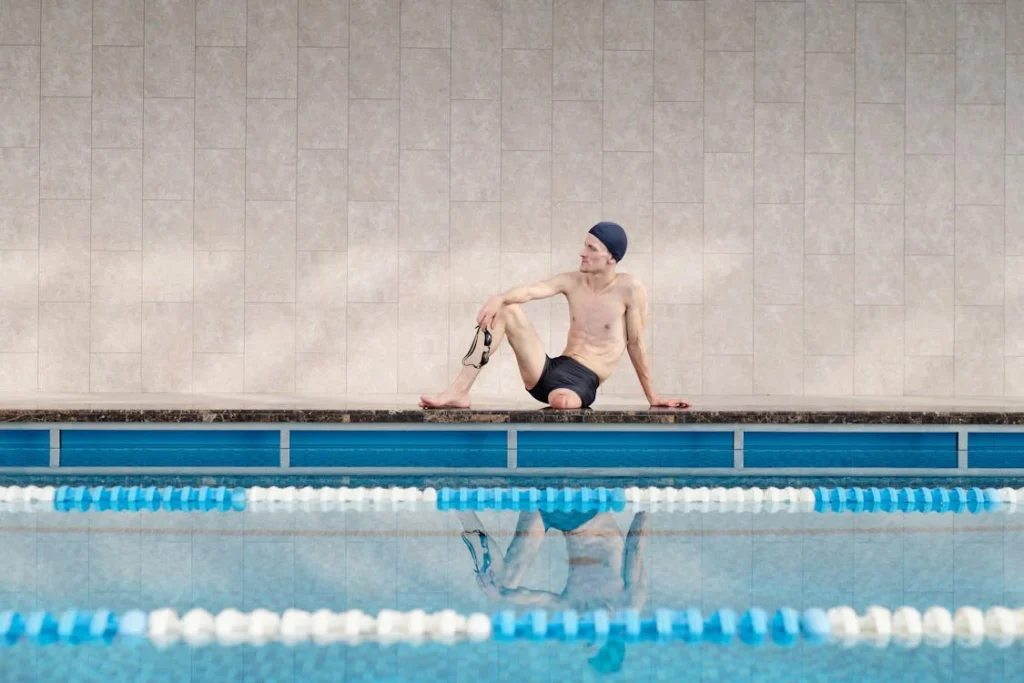Recovering from limb loss isn’t just about healing. It’s about getting ready — fully and properly — for what comes next. And before you ever take that first step with a prosthetic, your body needs to learn how to move again. That’s where pre-prosthetic exercises come in.
These exercises are the quiet heroes of recovery. They don’t just rebuild strength. They prepare your muscles, joints, and balance for a new way of living. They teach your body how to adjust. And they help you feel more in control — even before a prosthetic is in place.
Many people think therapy starts after the prosthetic arrives. But the truth is, your success starts long before that. How well you move, how confident you feel, how smoothly your fitting goes — all of it begins with the right preparation.
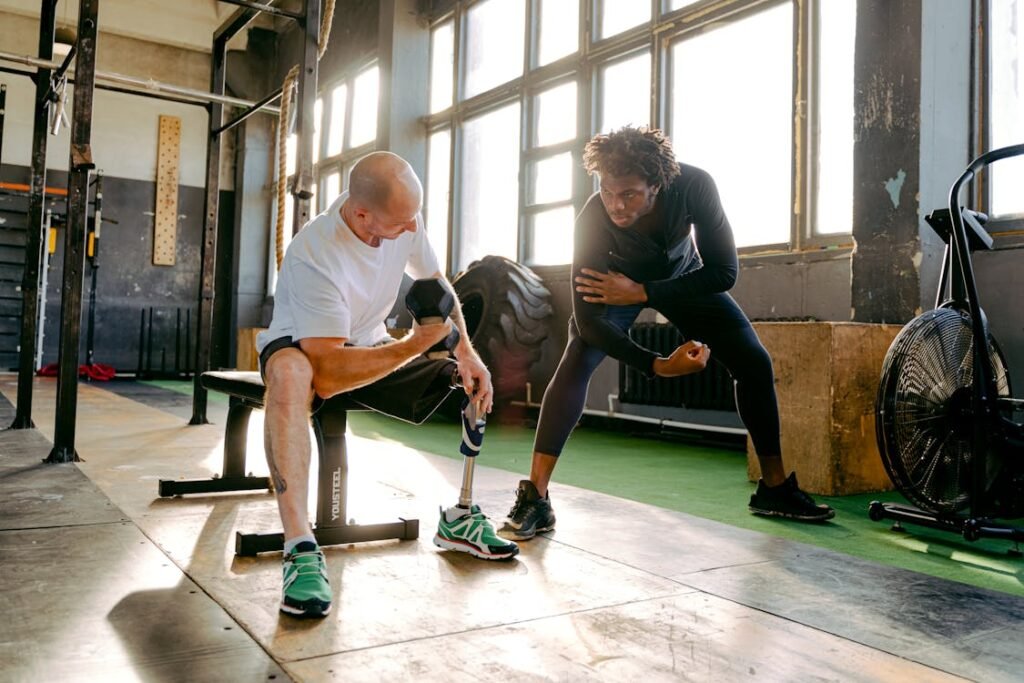
Why Pre-Prosthetic Exercises Matter More Than You Think
What Happens to the Body After Amputation
When someone loses a limb, the body doesn’t just stop at healing the wound. It starts to adapt — fast. Muscles that once supported movement lose their purpose. Nerves begin to respond differently. The brain, which was used to sending signals to a full limb, suddenly finds part of that pathway missing.
At the same time, the body naturally begins to guard the area around the amputation site. You might lean more to one side. You may start to move less because of pain or fear. While all of this is a normal part of healing, if left unaddressed, it can cause long-term problems.
Joints may become stiff. Muscle tone may fade. Your posture can shift in ways that cause pain down the line. And when it comes time to use a prosthetic, all these small issues can add up — making the adjustment harder, more painful, and slower.
That’s why pre-prosthetic exercises are so important. They don’t just help you feel stronger. They actually prepare your whole body to use a prosthetic more easily and more naturally.
The Goal: Balance, Strength, and Awareness
The exercises you do during this phase are about much more than building muscle. They help your brain and body reconnect. They improve your balance, which is essential when you’ve lost part of your support system.
They increase core strength, which helps stabilize you when you sit, stand, or walk. And they build awareness — the kind that helps you stay in control when trying out a prosthetic for the first time.
Every movement you make helps your body remember how to shift weight, hold posture, and respond to small changes. These are skills you’ll rely on every single day once you get your prosthetic.
Pre-prosthetic exercises also help shape your residual limb by improving blood flow and reducing swelling. They can ease phantom pain, reduce tightness in the muscles, and help protect nearby joints that are now doing extra work.
And perhaps most importantly, they give you something to work toward each day. A goal. A rhythm. A reason to move when staying still feels easier.
Before You Begin: How to Prepare
Before doing any exercise, your therapist will usually check a few important things. They’ll make sure your wound is healing properly. They’ll check for swelling or infection.
They’ll make sure your limb is wrapped or protected in the right way. They’ll also ask how you’re feeling emotionally — because mental readiness is just as important as physical ability.
Once you’re cleared to start, your exercises will begin gently. You won’t need equipment at first. Most movements can be done from bed or a chair. The focus will be on small, controlled actions — the kind that build strength slowly and safely.
You don’t need to rush. You don’t need to push through pain. You just need to show up, one small step at a time.
Some people begin with breathing exercises or posture work. Others start with gentle tightening and releasing of muscles — something as simple as squeezing the muscles in your residual limb and then letting go.
These actions may seem small, but they’re powerful. They begin the process of reawakening your body.
Therapists also guide you through safe body positioning. If you’ve had a lower limb amputation, this might mean lying flat with your hip straight to avoid tightness. If you’ve had an upper limb amputation, you may be shown how to keep your shoulders aligned and prevent stiffness in your neck or back.
It’s not about intensity. It’s about intention. Moving with purpose, even a little each day, sets the stage for a stronger future.
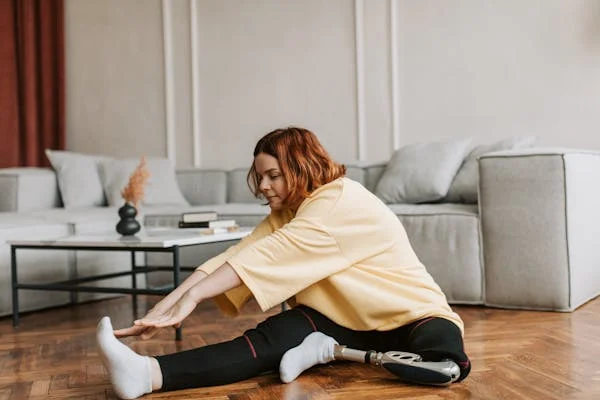
Targeted Pre-Prosthetic Exercises for Upper and Lower Limb Amputees
Exercises for Lower Limb Amputees: Building a Strong Foundation
When someone loses a leg — whether above or below the knee — the entire way the body moves, balances, and rests changes. The first goal is to protect your joints, especially your hips and knees, and then start building back strength and symmetry.
In the early stage, much of the work happens while you’re lying on a bed or sitting. Even here, small movements matter. Tightening the thigh muscles of your residual limb, holding for a few seconds, then slowly releasing helps build basic muscle tone.
These are often called quad sets, though names aren’t important — it’s the feeling of engaging and relaxing that does the work.
Another important movement is hip extension. After lying in bed, many people develop tight hips, which affects their ability to stand upright. Lying on your stomach for a few minutes each day — as directed by your therapist — gently stretches the front of the hip and helps keep the joint mobile.
This positioning alone can make walking with a prosthetic feel more natural later.
As your strength improves, exercises start to include gentle leg lifts, either straight or at an angle, to help activate your core and improve balance. Your sound limb also gets attention. It takes on more pressure, so strengthening it helps avoid overuse or strain injuries in the future.
Balance training starts early too. Just sitting upright on a firm surface and reaching slightly forward or to the sides helps your body relearn how to shift weight safely. These exercises may seem simple, but they rebuild your body’s natural responses — preparing you to walk again with more confidence and control.
Exercises for Upper Limb Amputees: Rebuilding Stability and Control
Upper limb amputations — whether above or below the elbow — bring a different set of challenges. You’re not dealing with weight-bearing in the same way as with legs, but you are navigating fine motor control, shoulder balance, and the ability to move with ease and purpose.
After surgery, the body often compensates for the missing limb by slumping the shoulder or twisting the spine. This causes poor posture, back strain, and discomfort. So one of the first focuses is keeping the shoulder level and mobile.
Your therapist may ask you to gently shrug your shoulders, roll them backward, or hold your upper arm in place while moving your shoulder blade. These movements keep your joints loose and encourage symmetry — so your body doesn’t start leaning or collapsing on one side.
Next comes core and posture work. Sitting upright with your spine straight and engaging your stomach muscles helps you stay centered. It supports your balance, improves breathing, and makes you more stable when doing everyday tasks like reaching or turning.
Then there’s phantom limb control — yes, you can train a limb you no longer see. If you’ve had an upper limb amputation, therapists often guide you through mirror therapy or imagined movement, where you think about moving your missing hand or arm.
This activates the brain’s motor pathways, reducing phantom pain and improving your eventual control of a prosthetic.
You may also practice lifting small objects with your sound hand or doing everyday tasks like brushing your teeth using your non-dominant side. This isn’t just physical training — it’s adaptation. You’re building new habits and preparing for a new kind of independence.
Strengthening Without Overdoing It
One of the key lessons across all types of pre-prosthetic exercises is that you don’t have to do a lot to make progress. You just need to do the right things, consistently, and with awareness.
Overworking your body too soon can lead to fatigue or injury. Underworking it can slow your recovery and cause stiffness. That’s why it’s important to follow a plan designed just for you, usually led by your therapist, and be patient with your pace.
If your body feels sore in a good way — like muscles waking up — that’s a sign you’re doing it right. If you feel sharp pain, swelling, or dizziness, it’s time to pause and check in with your care team.
The best exercises are the ones that build strength and confidence. They help you feel in control of your body again. And they remind you that you’re not just healing — you’re preparing to move forward.
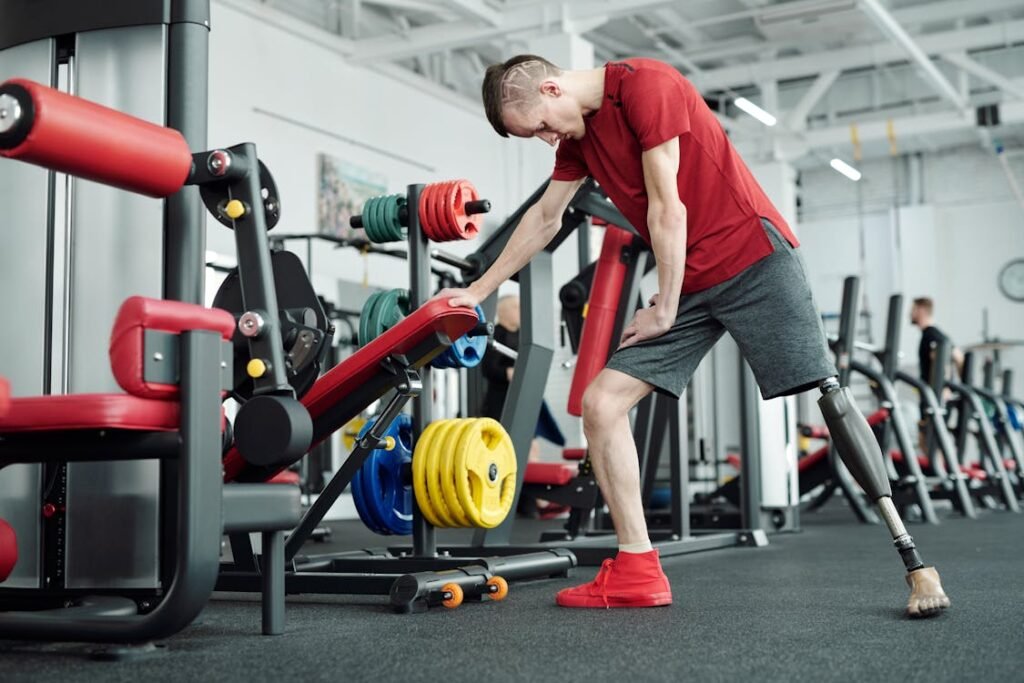
Creating a Pre-Prosthetic Exercise Routine That Works for You
Routines Give You Rhythm — and Results
After limb loss, so much in life feels unpredictable. You’re adapting to a new body, new sensations, and often new limitations — all at once. That’s why having a daily exercise routine can be so helpful. It gives your day structure.
It gives you something to count on. And it reminds you that progress is being made, even when it’s not always easy to see.
A routine doesn’t have to be long or difficult. In fact, it’s better if it’s short, focused, and easy to repeat. That way, even on days when you feel tired, sore, or unmotivated, you can still do something. And every little bit adds up.
Think of your routine like brushing your teeth. You don’t need to be in the mood — you just do it because it matters. Pre-prosthetic exercises work the same way. Consistency brings change, not intensity.
When to Exercise: Find Your Natural Flow
Some people feel most motivated in the morning. Others do better in the afternoon or evening. There’s no perfect time — only the time that works for you. The key is to pick a moment when you’re least likely to be interrupted and most able to focus.
You might start your day with a few simple movements before getting out of bed — like tightening your residual limb muscles or sitting upright with good posture. Later in the day, you might do balance or core work when your body is more awake.
If energy is an issue, try spreading your exercises across the day instead of doing them all at once. Five minutes here, ten minutes there — it’s all progress. This flexible approach often works better than trying to push through a full session when your body isn’t ready.
Therapists often suggest pairing your exercises with something you already do daily — like after brushing your teeth, before meals, or while watching TV. These anchors make the habit stick faster, without requiring extra thought or planning.
How to Stay Motivated When Progress Feels Slow
Let’s be honest — some days are going to feel hard. You might not see visible progress right away. Your limb might feel tight or sore. You might feel frustrated, comparing where you are to where you want to be.
That’s okay. That’s part of healing.
One way to stay motivated is to track your efforts, not just your outcomes. Instead of focusing only on results — like how far you can lift your limb or how long you can balance — write down what you did each day. Did you sit upright? Did you do a few reps of muscle tightening? Did you show up, even when you didn’t feel like it? That’s a win.
Another trick is to celebrate the smallest victories. Maybe today you moved with less pain. Maybe your posture was straighter. Maybe you wrapped your limb more confidently. These moments matter. They build your momentum and remind you that you’re moving forward.
You can also ask your therapist or caregiver to help set short-term goals with you. These goals don’t need to be big — they just need to be clear. For example, “Sit unsupported for 30 seconds” or “Lift the limb five times without shaking.” Hitting these milestones gives you a real sense of progress and purpose.
Adapting Your Routine to How You Feel
Every day is different. Some days your energy will be high. Other days, you’ll feel low — physically, emotionally, or both. And that’s normal.
Your routine should be flexible enough to match your body’s needs. On high-energy days, you can try adding a new movement or holding a position a little longer. On low-energy days, just stick to the basics. Even five minutes of movement can make a difference — for your body, your mind, and your sense of control.
And remember: rest is also part of recovery. If your limb is sore, swollen, or irritated, take a break and give your body space to repair. Recovery is not linear. It goes up and down. What matters is that you stay in motion — mentally, emotionally, or physically — even in small ways.
That mindset keeps you in control. And being in control is one of the best feelings during recovery. It turns passive healing into active strength-building.

How Support Systems Shape Success in Pre-Prosthetic Exercise
The Role of Therapists: Your Movement Mentors
Your physical or occupational therapist is more than just someone who tells you how to move. They’re your guide through one of the most delicate, personal stages of recovery. A good therapist doesn’t just hand you a set of exercises — they watch how you move, how your limb responds, and how your mind is coping.
They adjust exercises to fit you, not the other way around. Maybe your balance is off one day. Maybe your limb is sore. Maybe you’re nervous or distracted. Your therapist notices. And then they work with you — not just on your limb, but on your confidence, your comfort, and your mindset.
Many therapists also help you track progress over time. They might take measurements, photos, or videos. Seeing your own growth in these ways can be deeply motivating, especially on days when change feels slow. It reminds you that healing is happening, even if you don’t always feel it in the moment.
Family and Caregivers: Your Day-to-Day Support
If you have a spouse, parent, child, or close friend helping you through recovery, their support can make a world of difference. They’re often the ones reminding you to move, helping you get into the right position, or cheering you on when you’re not feeling strong.
But caregivers aren’t just there for the hard days. They can also be powerful partners in keeping your routine going.
For example, they might do the exercises with you, keep track of your progress, or even help adapt the home environment to make movement easier — like setting up a firm chair, a soft mat, or a corner with good lighting and space for stretches.
It’s important, though, that caregivers support without taking over. The goal isn’t to make things easier by doing everything for you — it’s to help you find your own rhythm and independence. The most helpful caregivers are the ones who encourage you to try, wait patiently, and offer help only when needed.
If you’re supporting someone who’s going through limb loss, remember: just being present is powerful. Even if you’re not a medical expert, your belief in them matters more than you know.
Creating a Healing Space at Home
Environment matters. If your space is cluttered, noisy, or stressful, it becomes harder to focus on recovery. That’s why setting up a small area just for your exercises — no matter how simple — can help your brain shift into “healing mode.”
This space doesn’t need fancy equipment. A firm chair, a clean floor, a mirror (if helpful), and maybe a soft mat are often enough. What matters more is that it feels safe, quiet, and dedicated — even if just for a few minutes each day.
Having a routine in a familiar space builds muscle memory. Over time, your body begins to associate that space with progress. That makes it easier to get started, even when motivation is low.
Some people also add calming elements — like soft lighting, gentle music, or even a photo that reminds them why they’re doing the work. These small touches can make a big difference in how you feel before, during, and after your exercises.
Finding Encouragement Beyond the Home
Sometimes the support you need doesn’t come from those closest to you. It comes from others who’ve walked the same path. That’s why connecting with peer support groups, online communities, or rehabilitation networks can be so powerful.
Talking to someone who’s been through limb loss, who’s learned to walk again or use a prosthetic, makes the journey feel more real — and more possible. You learn from their stories. You’re reminded that others have faced what you’re facing. And more importantly, you’re reminded that they got through it — and so can you.
At Robobionics, we often hear from users who say the people they met during recovery became just as important as the devices they received.
That kind of emotional connection — whether through support groups or clinic-based programs — creates momentum. It helps you believe in the process, and in yourself.
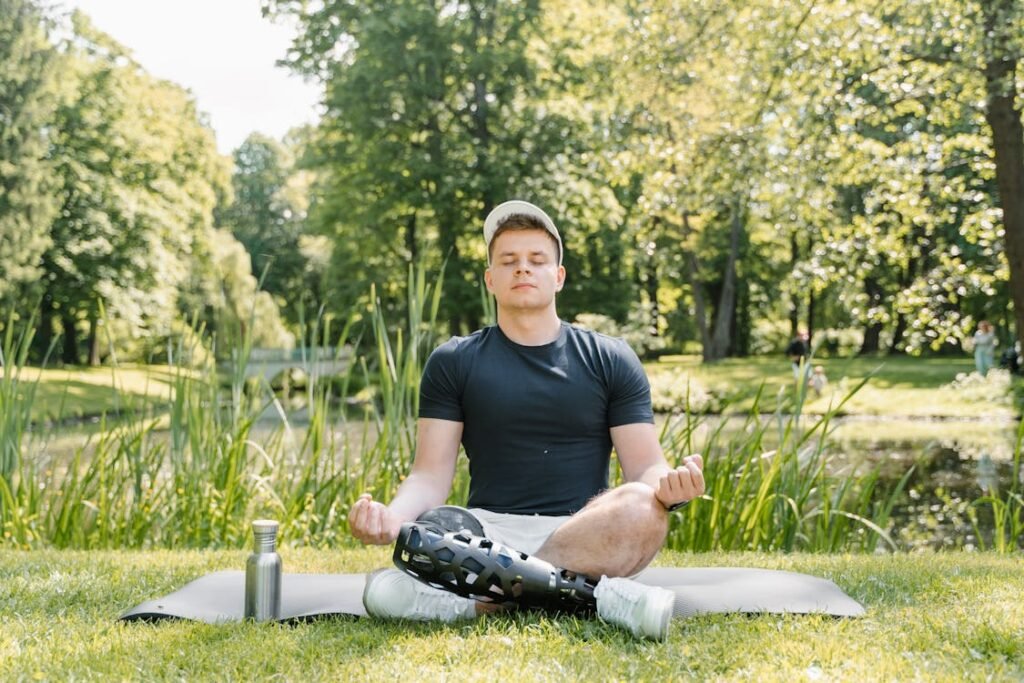
The Power of Breath: Using Breathing to Support Pre-Prosthetic Recovery
Why Breathing Is More Than Just Breathing
When most people think of recovery exercises, they picture stretches, lifts, or balance work. But before any of that, before even moving a muscle, comes something more basic — your breath. And in recovery, it’s one of the most powerful tools you have.
Breathing seems automatic — something that just happens. But when done intentionally, it becomes a tool for calming your nervous system, reducing pain, and even improving movement control. This is especially important for amputees, who often deal with a mix of physical strain, anxiety, and emotional overwhelm during the healing process.
Controlled breathing helps you stay grounded when you’re working through pain. It helps you stay focused when you’re doing a difficult movement. And it connects your body and mind, so you’re not just going through the motions — you’re actually feeling your recovery.
Breathing Through Discomfort, Not Around It
One of the early challenges in pre-prosthetic exercises is the discomfort that comes with re-engaging weak or tight muscles. Instead of holding your breath — which often happens unconsciously — learning to breathe through the movement can reduce tension and improve outcomes.
For example, when doing a muscle squeeze or gentle limb lift, breathing out during the effort helps your body release resistance. It softens the surrounding muscles, helps oxygen flow more freely, and keeps your mind calm. This allows for smoother movement and less strain.
The same goes for stretching or positional exercises. When you’re lying on your stomach to stretch your hip, or sitting upright to train your core, breathing slowly can help the body settle into the posture. It prevents bracing and reduces the risk of overcompensation, especially in your neck, shoulders, or back.
Breath as a Tool for Emotional Recovery
Losing a limb is a deep emotional experience. Alongside physical healing, there’s often anxiety, sadness, fear, or anger. These emotions can build up and show themselves physically — tight chest, shallow breathing, restlessness.
Breathwork can break that cycle. Taking slow, deep breaths helps activate your body’s parasympathetic system — the “rest and recover” mode. This lowers heart rate, reduces stress hormones, and sends a message to your mind: you are safe, you are okay, you are healing.
Even a few minutes of breath-focused stillness before or after exercise can shift your mindset. It can transform therapy from something mechanical into something meaningful. You’re not just doing it to build strength. You’re doing it to reconnect with your body — gently, patiently, fully.
How to Start Using Breath in Your Routine
You don’t need to be a meditation expert or follow complex breathing techniques. You just need awareness.
Try this: before your next set of exercises, sit still. Inhale slowly through your nose for a count of four. Hold the breath gently for two counts. Then exhale through your mouth for four counts. Repeat this three or four times.
This clears the mind. It slows down anxious thoughts. It prepares your body for intentional movement.
As you start your exercises — whether it’s tightening your limb muscles, balancing on the edge of your seat, or lifting an arm — breathe with the movement. Inhale during preparation, exhale during action. Keep the rhythm soft and steady.
Over time, this rhythm becomes part of your flow. It makes your movements more graceful, your mind more focused, and your sessions more restorative.

Sleep and Strength: Why Rest Is a Key Part of Pre-Prosthetic Progress
Recovery Doesn’t Only Happen During Movement
When we talk about building strength and preparing for prosthetic use, it’s easy to focus on what happens during therapy. We think about stretching, strengthening, wrapping, balancing — all active parts of recovery. But what you do between sessions, especially while sleeping, is just as important.
Sleep isn’t just rest — it’s rebuilding. It’s the time when your body repairs damaged tissues, calms inflammation, resets your nervous system, and stores the progress made during the day. If your sleep is poor, your body doesn’t fully absorb the benefits of your exercises. Over time, this can lead to stalled progress or even setbacks.
Many amputees struggle with sleep, especially early in recovery. Pain, stress, phantom limb sensations, and changes in routine can all disrupt your ability to fall asleep or stay asleep. But without consistent rest, the muscles you’re trying to strengthen don’t get the time they need to grow.
The joints you’re trying to protect don’t get the recovery they require. And your mental stamina begins to drop — making motivation harder to find.
Sleep and Muscle Memory Go Hand in Hand
One surprising thing about sleep? It helps lock in what you learned during the day. This is especially important in pre-prosthetic rehab, where you’re teaching your body and brain how to move in new ways.
Whether it’s shifting your weight, controlling your posture, or lifting your residual limb, these patterns become muscle memory — and much of that memory formation happens while you sleep.
Your brain reviews the day’s movements while you’re resting. It files away what worked, fine-tunes the details, and gets ready to do it better the next time. So if you’re practicing balance or building core strength, sleep helps those new skills settle in — making the next session smoother, easier, and more effective.
Without enough sleep, even simple movements can feel harder. Your body is slower to respond. Your mind is less focused. You may feel off-balance or less motivated. It’s not that you’re doing something wrong — it’s that your system is running on low battery.
How to Improve Sleep During Recovery
Improving sleep during limb recovery isn’t always easy, especially if you’re dealing with post-surgical discomfort, anxiety, or a disrupted daily rhythm. But even small changes can help restore your natural sleep cycle and support better healing.
Start by building a calming wind-down routine in the hour before bed. Avoid screens, bright lights, or stressful conversations. Try soft music, reading, breathing exercises, or gentle stretches that tell your body it’s time to rest. This calming pre-sleep period helps signal your brain to slow down.
Pain can also disrupt sleep. If you’re struggling with discomfort, speak to your rehab team about adjusting your positioning, using pillows to support your limb, or finding safe pain-relief methods.
Sometimes even changing your sleeping surface — a firmer mattress or a softer pillow under your limb — can reduce tension and make it easier to relax.
Creating a regular sleep schedule also matters. Going to bed and waking up at the same time each day helps reset your internal clock. This rhythm helps your body fall asleep faster and stay asleep longer — giving you more deep, restorative rest.
And if sleep is interrupted by emotional distress or phantom limb pain, don’t ignore it. These are real and common challenges. Talk to your therapist or counselor. Sometimes just understanding what’s happening in your body can reduce the fear that keeps you awake.
Rest Days Are Not Lazy Days
Finally, it’s important to know that taking a day off doesn’t mean you’re giving up. It means you’re giving your body time to adapt. Rest days are part of the program — not a break from it.
Some of your strongest muscles will be built during sleep, not during movement. That’s how recovery works. You work, you rest, you heal. Then you grow.
When you start seeing sleep as part of your exercise plan — not separate from it — everything shifts. You stop pushing through exhaustion. You stop seeing stillness as weakness. You start giving your body the space it needs to do what it’s designed to do: recover.
Conclusion: Small Movements, Big Changes
Pre-prosthetic exercises aren’t just preparation — they’re transformation. Every stretch, every breath, every small lift is your body learning to adapt, to strengthen, and to move forward. These early movements shape how your prosthetic fits, how it feels, and how confidently you live with it.
But recovery isn’t only about the physical. It’s also about how you sleep, how you breathe, how you eat, and who supports you. Every part of your day contributes to healing. And healing doesn’t follow a straight line — it follows your rhythm.
Whether you’re just starting or working through your routine, remember this: you’re not waiting to heal. You’re already healing. Every moment of care, every act of movement, is proof.
So take a breath. Take your time. And take the next step — your future is being built with each one.



